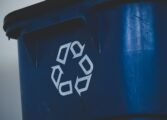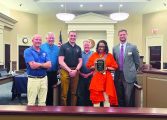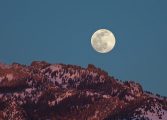By Page H. Gifford
Correspondent
The Lake Monticello Wildlife Committee sponsored a program by EarthQuest, a non-profit organization on Sept. 18. Located in Virginia and Georgia, they provide environmental and conservation education focusing on non-releasable birds of prey and rescued parrots. Steve Hoddy founded EarthQuest over 30 years ago. A master falconer since he was in his teens, he has been involved for 50 years in wildlife education.
Director of Operations Robert Haynes spoke to a crowd of nearly 100 people, mostly families with children who were excited and delighted to see the birds up close and to learn about them. Many bird watchers of all ages were also in attendance.
Elizabeth Rand, brought out a rescued macaw, a big bird, who quietly nuzzled Rand as she visited the crowd. The macaw was rescued from a woman who said he was aggressive and attacking her daily.
“They liked to be bathed and when he came to us, he hadn’t been, he was in poor condition and his feathers were all stuck together,” said Haynes, who added once rescued he evolved into a brighter, happier bird, never showing any further signs of aggression.
The falcon had a lot to say as Haynes introduced her. Normally, falcons loath and fear humans but can work with and become used to humans but never bond with them.
“They are diurnal and hunt during the day unlike owls who are nocturnal,” said Haynes. “They will often collaborate with other hawks to kill prey. The fastest bird, it has a diving speed of 242 miles per hour and folds its wings to catch prey.”
He talked about the near extinction of the peregrine falcons back in the 1970s when it was discovered that there were only 350 nesting sites left. It was biologist Rachel Carson, who while working for the government, uncovered evidence through her research that led to DDT being responsible. The chemical was released into the ecosystem and thinned out the eggshells, dehydrating the babies. When the government ignored her warnings she left and published the now famous book titled “The Silent Spring.”
Bugo the owl, who was large and beautiful with an inquisitive look, rotated his neck to get a better look at the crowd as he perched on Haynes’ arm.
“They have a highly developed sense of smell and hearing and are far-sighted. They can turn their heads to the back farther than we can but not quite all the way around. When they fly they are silent, no one hears it.”
Turkey vultures are a common sight on the side of the road in packs feeding off roadkill. Unlike most birds, they feed this way because their talons are not strong enough to carry prey.
“Vultures don’t spread diseases,” he said. “They have such strong acids in their stomachs that they can kill anthrax, botulism, cholera, rabies, and many more dangerous diseases. When vultures clean a carcass that has died of a serious disease, the disease is destroyed within their digestive system.”
Haynes said Toohoo had fallen out of his nest and was found by a couple of hikers, who took him along with them and fed him. He reinforced with the audience never to remove wildlife from the area in which you find them because the mother will return.
“Now, he imprinted on humans and had become domesticated and could no longer live in the wild.” TooHoo became another non-releasable bird saved by EarthQuest.
For more information about EarthQuest visit https://www.earthquest.org/.




